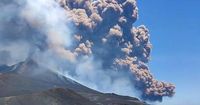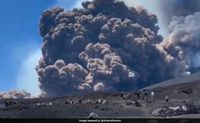Mount Etna, Europe's most active volcano, erupted vigorously on Monday, June 2, 2025, sending towering plumes of ash and smoke into the Sicilian sky and prompting tourists to flee in panic from its slopes. The eruption, characterized by a pyroclastic flow and lava fountains, unfolded over several hours, showcasing the restless nature of this iconic stratovolcano.
Located on the eastern coast of Sicily in the province of Catania, Mount Etna stands at roughly 3,300 meters (10,827 feet) and is renowned as the most active volcano in Europe and the most active stratovolcano in the world. Its long history of eruptions dates back to as early as 425 B.C., making it one of the most studied volcanoes globally. The volcano’s activity is fueled by its position atop a tectonic subduction zone where the African Plate moves northward beneath the Eurasian Plate, causing magma to originate from material melting in the mantle above these plates.
According to Italy's National Institute of Geophysics and Volcanology (INGV), the volcanic unrest began during the pre-dawn hours of June 2, with seismic tremors starting around 10 PM local time the night before and peaking just before 1 AM. This early activity escalated into “intense and almost continuous” strombolian explosions, a type of relatively low-level eruption that releases a modest amount of energy but can produce spectacular displays of volcanic bombs and lava fountains.
As the day progressed, the explosions intensified. INGV reported “explosions of increasing intensity” that were “almost continuous,” culminating by noon local time with the explosive activity from the Southeast Crater transforming into a lava fountain. Infrared images shared by INGV Vulcani showed molten lava flowing steadily down the mountain’s face, confirming the volcano’s heightened activity.
The eruption was triggered by a collapse of material from the northern side of the Southeast Crater, which produced a dangerous pyroclastic flow—a fast-moving current of hot gas, ash, and volcanic rock. This flow raced down the volcano’s slopes but, according to INGV officials, did not cross the edge of the Valley of the Leo, a nearby geographic feature. Nonetheless, the pyroclastic flow caused significant alarm among tourists on the mountain.
Several videos circulating online captured the dramatic scenes as visitors and hikers scrambled for safety, running down the mountain trails to escape the encroaching ash and smoke. One particularly striking video showed tourists fleeing along a path as a massive plume billowed behind them. Despite the chaos, there were no reported injuries as of Monday evening.
Authorities took precautionary measures by blocking off the area around the summit to tour groups, recognizing the dangers posed by the ongoing eruption. Ashfall was reported in nearby areas such as Piano Vetore, and the Volcanic Ash Advisory Centre in Toulouse issued a “code red” alert due to the ash plume reaching approximately 6,400 meters into the atmosphere. This ash cloud also prompted concerns about air travel, although no immediate disruptions were reported.
Mount Etna’s frequent activity is well-known to the local population, who are accustomed to annual eruptions that sometimes blanket nearby towns in volcanic dust but rarely cause major harm. The volcano has erupted at least once every year in recent years, including a significant eruption just over a year ago and another earlier this year on February 11, when it spewed hot ash and lava from its 3,400-meter summit.
Scientists have long studied Etna to understand the complex interactions between tectonic movements and volcanic activity. Seismic tomography has been used to explore the magma pathways beneath the volcano, shedding light on how the African and Eurasian plates’ collision drives Etna’s eruptions. The volcano’s location in a geologically complex region marked by mountain ranges, fault systems, and ongoing tectonic shifts makes it a key site for research on volcanic and seismic phenomena.
Despite the dramatic nature of the June 2 eruption, officials emphasized that the risk to the wider population remains low. Renato Schifani, head of Sicily’s regional government, reassured the public by stating that the pyroclastic flows “posed no danger to the population” of the island. INGV official Stefano Branca also noted that the only danger was near the summit, where access was restricted.
As the eruption unfolded, social media was flooded with footage and images from locals and tourists alike, capturing the raw power of Mount Etna’s latest display. From videos of lava fountains and ash plumes to scenes of tourists fleeing down the slopes, the eruption reminded the world of the volcano’s formidable presence.
While the volcanic activity continues to be monitored closely, the current eruption underscores the dynamic nature of Mount Etna and the ongoing geological processes shaping Sicily. The volcano’s persistent eruptions, ranging from explosive blasts to lava flows and ash emissions, continue to be a source of fascination and study for scientists and a reminder of nature’s volatile power for residents and visitors alike.





